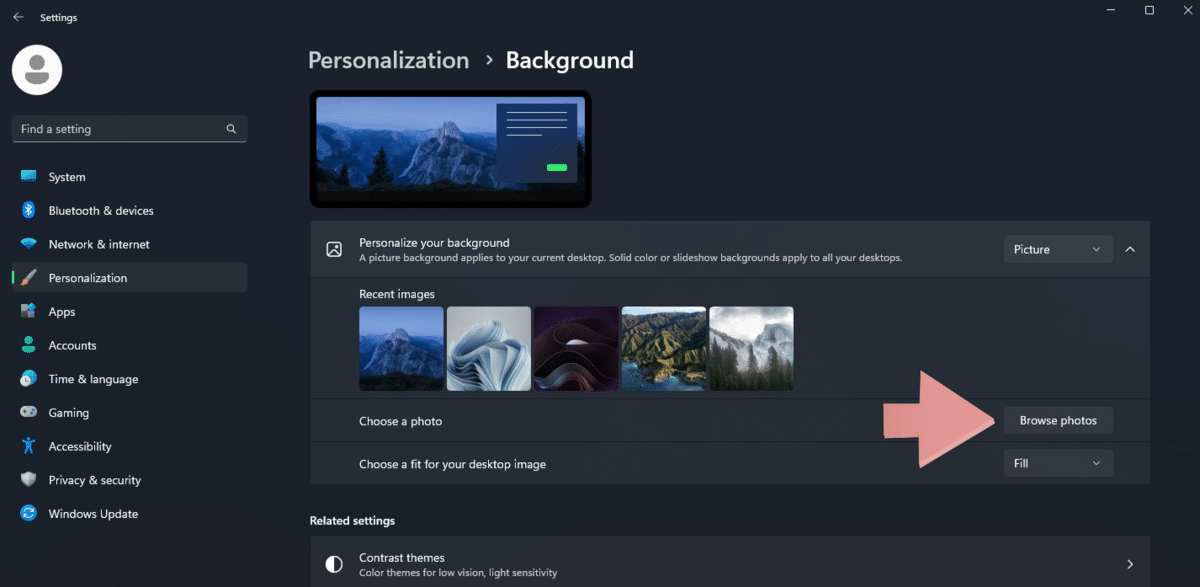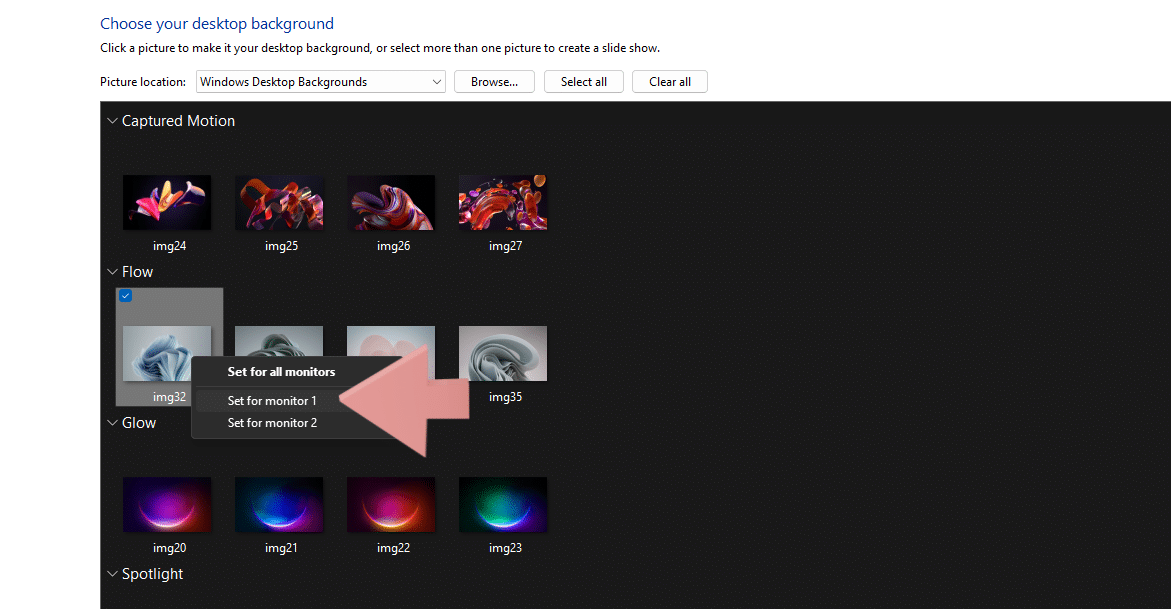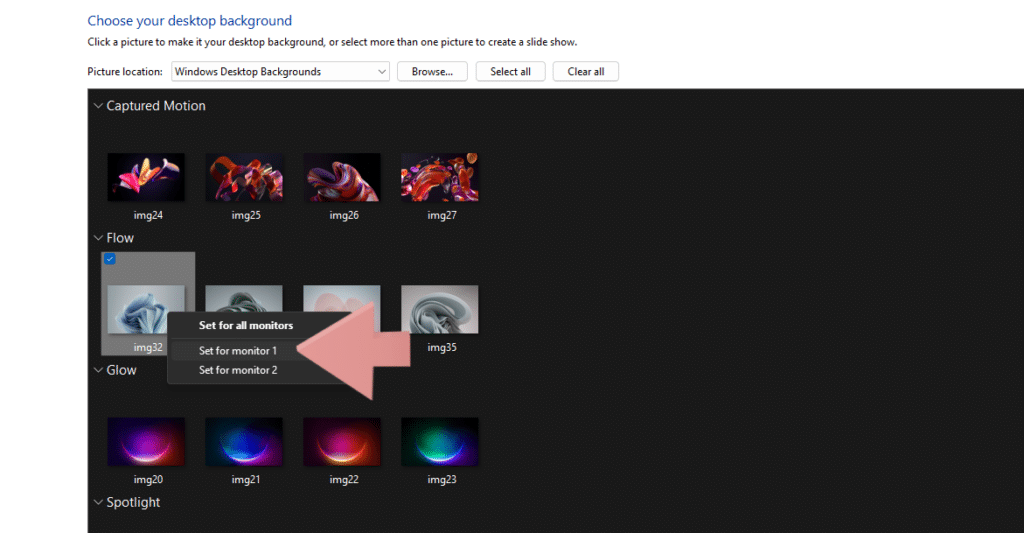Are you sick of the stock background on your desktop monitors? Or maybe you have a single stretched out image across several screen. In either case, this guide will show you how to put a different background on each monitor on you Windows PC. Read on to learn all the simple ways you can do it.
This Article Covers:
How to Check the Number of Monitors in Windows
Before applying a different background on each monitor, you need to know the number of your monitor in Windows. Doing this is simple and requires you to follow these simple steps:
- Click on the Start button and click on Settings.

- In the settings menu, click on System and head over to Display.

- This will open a page where you can see your monitors in their proper orientation. Under the displays, click on the Identify button. This will show a large number indicating the number of the monitors. Related: Why Does My Monitor Keep Going Black?Keep these in mind when selecting different wallpapers on different monitors. Make sure you have your best monitor set to screen one.
How to Have Different Wallpapers on Each Monitor Using Settings
Thankfully, the option for Windows 10 and 11 to have different backgrounds per monitor is built natively into Windows by Microsoft. Here is how to set two different wallpapers using the Windows settings:
- Go to the Settings.

- In the left sidebar, you will see the Personalization option; click on it. Now choose the Background option. This will let you see the settings that are related to your wallpaper.

- Choose the Browse Photos option, which will be next to the Choose a Photo option. This will let you choose the wallpaper that you prefer.

- In the Recent images page, the image will appear, right-click on it and click on the Set for monitor 1 option. This will set the wallpaper for your first monitor.
- On another image, right-click on it and choose the Set for monitor 2 option. This will set the wallpaper for your second monitor.
How to Set Different Wallpaper for Each Monitor Using File Explorer
Often, you don’t want to head into the settings to tinker with the wallpapers every time you find a new wallpaper you wish to have on your screen. In these cases, you can use Windows file explorer to do this. Although this won’t allow you to have better control over which image you wish to have for a specific monitor, it will allow you to change the images on your monitors instantly.
Here is how to set different wallpapers on dual monitors using the file explorer:
- Locate the folder where you saved the images you want to set up as backgrounds on your monitors. Select the images that you wish to set as background on each of your monitors. You can do this by keeping the Ctrl button pressed on your keyboard and clicking on multiple images that you want to use.

- After selecting multiple images, right-click on any of them and click on the Set as desktop background option. All of your monitor screens will have different backgrounds.

- To switch one background with the other, right-click on the desktop background and click on the Next desktop background button.
This option is great if you don’t care about the placement of the images on your monitors. However, if you wish to be meticulous with the placement of the background images, use the other two methods in this article.
Set Different Wallpaper on Each Monitor Using the Control Panel
With only a few clicks in Windows 10 and 11, you can quickly change the background on each display. However, it’s not immediately clear where you need to click. This method uses a control panel instead of going to the settings menu in Windows. This will give you more control over each monitor’s different backgrounds.
Here is how to have two different wallpapers on dual monitors Windows 10 and 11:
- On your computer, go to the Run dialogue box. You can use the Win+R keys from the keyboard on Windows or open the Start menu, type Run and launch it from there.

- In the dialog textbox, type the following command:
shell:::{ED834ED6-4B5A-4bfe-8F11-A626DCB6A921} -Microsoft.PersonalizationpageWallpaper
- Click on the OK button to execute the added command.

- Control Panel will open with the settings of the desktop background. Choose the Browse option and choose the picture you wish to put as the background. Do the same again to add the second image. Don’t worry about what your background looks like right now.

- To set the images for monitors individually, right-click on the image and click on the Set for Monitor 1 option. This will set the wallpaper for your first screen.
- On the image of your choice, right-click on it and choose the Set for Monitor 2 option.
- After setting up the images, click the Save Changes option.
Using Third-party Alternative
When it comes to advanced background customization, the Windows default personalization options are more limited than third-party apps. Thankfully, a lot of third-party software allows you to have full control over the background images for your displays.
You may access other functionality like directly setting pictures from the web, multi-monitor taskbars, Windows administration, and locking/unlocking the mouse pointer to the active display via third-party applications like DisplayFusion and John’s Background Switcher.
How to Change the Images Automatically After a Certain Time
Microsoft allows users to change the background images automatically after a specified time. You can do this by turning on the slideshow feature in Windows 10 and 11.
To do this:
- Go to Settings and then to Personalization. There, click on Background. Here, click the Background section and then click on the Slideshow option.
- Under the Choose albums for your slideshow option, click on the Browse option.
- Select a folder that contains the images.
- Under Change picture every section, click the option and select the desired time. For example, if you wish to have four images to cycle through.
- Make sure that Shuffle is turned off.
Frequently Asked Questions
Can I Have 2 Different Backgrounds on Dual Monitors?
Yes. It is possible to have different wallpaper per monitor. For separate wallpapers in Windows 10, open Settings and click on the Personalization option, click on it. Now choose the Background option and choose the Browse Photos option, which will be next to the Choose a Photo option. This will let you choose the wallpaper that you prefer. In the Recent images page, the image will appear, right-click on it and click on the Set for monitor 1 option. This will set the wallpaper for your first monitor. On another image, right-click on it and choose the Set for monitor 2 option. This will set the wallpaper for your second monitor.
Can You Have 3 Different Backgrounds on Each Monitor?
Windows can have different backgrounds per monitor. You can do it by pressing the Ctrl key on your keyboard while choosing different wallpapers that you wish to put as backgrounds on your monitor screens. Depending on the number of monitors you have, select the number of images. Right-click on any selected images and choose the Set as desktop background option. You will be able to see different wallpapers on your monitors. If you want to switch the wallpapers, right-click on that monitor and choose the Next Desktop Background option.
How Do I Use a Large Image to Spread Across All My Monitors?
To spread a large image across all monitors, on your desktop background, right-click and choose the Personalize option. Choose a photo with a resolution that can fit on your multiple screens. To position your image, select the Span option. Click on the Save Changes option.
The Best Laptop for Multiple Screens
Razer Blade 14 Gaming Laptop
Wrapping Up How to Have Different Wallpaper fo Each Monitor
Each of the above-mentioned methods to have a different background on each monitor in Windows 10 and 11 is fairly straightforward. But, the easiest is likely just going through the Windows settings and selecting a background for each monitor from there. If you’re having any trouble, let us know in the comments, and we’ll help you from there. If you found this tutorial useful, check out our related articles below.
Related:


